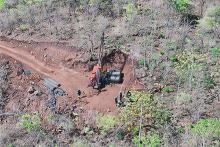Lindian Resources has tabled some of its best assays from drilling at its Kangankunde project in Malawi, with results going up to 13.89 per cent TREO. The company says the average grade of the rare earths critical metal elements, neodymium and praseodymium, was 20 per cent TREO. Three holes went more than 3 per cent TREO across intersections running 150m or more from surface.


Lindian Resources has tabled some of its best assays to date from drilling at its Kangankunde project in Malawi, with results going up to 13.89 per cent total rare earths oxides (TREO).
Three separate holes returned grades going more than 3 per cent TREO across intersections running 150m or more from surface. The first hole returned 184m averaging 3.55 per cent TREO from 4m, another hole delivered 160m averaging 3.04 per cent from surface and the trio was wrapped up by a 150m strike averaging 3.02 per cent. Importantly, the mineralisation remains open at all three holes.
Management says the average grade of the rare earths critical metal elements, neodymium and praseodymium (NdPr), was 20 per cent TREO, while the mineralisation was found to have low levels of thorium and uranium.
Demand for NdPr is linked largely to their critical role in permanent magnets used in electric vehicles and renewable energy devices. In a recent report, independent research body Adamas argued the lack of new primary and secondary supply sources for rare earth oxides in the market from 2022 onwards, coupled with the inability of existing producers to increase their output, will create a major NdPr oxide shortage by 2035.
Lindian Resources chief executive officer Alistair Stephens said: “The results reinforce our firm belief that Kangankunde is rapidly emerging as one of the world’s Tier 1 rare earths deposits. These high-grade results are largely from the northern part of the central carbonatite, an area that is showing considerable promise, and for which further assays are pending.”
Kangankunde is considered one of the world’s biggest rare earths operations outside China and hosts an outdated resource of 2.53 million tonnes grading 4.24 per cent TREO for 107,000 tonnes of contained rare earths when using a cut-off grade of 3.5 per cent. It is a carbonatite-hosted system and notably, the mineralisation is exposed at surface and still open at depth.
Lindian has completed phase one of its 14,000m resource definition drill-out, with assays from 49 holes still outstanding. However, the company has already kicked off a phase-two orebody extension program of two 1000m holes, with RC collars to 150m completed for each.
Diamond drilling is now underway at the site and management says it remains on track to deliver a maiden mineral resource update under JORC 2012 guidelines this quarter.
With the United States currently scrambling to try and break the near monopoly that China holds over rare earths supply, Africa and its resource wealth is likely to become an attractive target. The Steenkampskraal mine in the Western Cape province of South Africa has the highest grade of NdPr in the world, positioning that country to become a significant supplier to the global market.
Forbes has calculated that by 2025, the demand for rare earths is expected to be 304,678 metric tonnes – up from from 208,250 metric tonnes in 2019.
Is your ASX-listed company doing something interesting? Contact: matt.birney@businessnews.com.au












